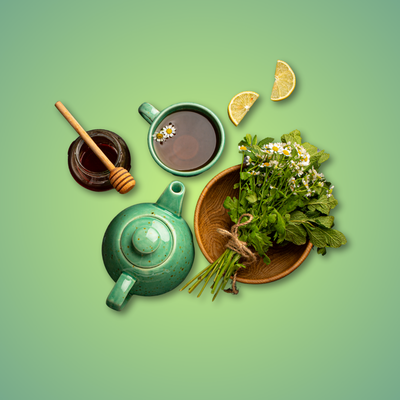For centuries, green tea has been more than just a soothing beverage; it has been a cornerstone of health and well-being in many cultures [1]. From ancient rituals to modern wellness routines, the allure of green tea persists, and for good reason. This guide will delve into the remarkable world of green tea, exploring its wide array of potential health benefits, with a particular focus on how this natural elixir can contribute to the vitality and wellness of women. Join us on a journey to uncover the secrets held within these verdant leaves and discover how easily you can incorporate the goodness of green tea into your daily life.
Unlocking the Potential: General Health Benefits of Green Tea
At the heart of green tea's health-promoting properties lies its rich composition of plant-based antioxidant compounds [3]. These powerful substances, known as polyphenols, include a particularly beneficial group called catechins, with epigallocatechin-3-gallate (EGCG) standing out as the most abundant and well-researched [3]. These antioxidants play a crucial role in neutralizing harmful free radicals within the body, which are unstable molecules that can damage cells and contribute to the development of various chronic diseases, including heart disease and cancer [1]. The presence of these potent antioxidants is a primary reason why green tea is considered such a valuable addition to a health-conscious lifestyle.
Beyond its antioxidant prowess, green tea offers notable benefits for cognitive function [5]. It contains caffeine, a well-known stimulant that can enhance alertness and improve brain function [5]. However, unlike coffee, green tea also boasts a significant amount of L-theanine, an amino acid that can promote relaxation without causing drowsiness [5]. This unique combination allows for a state of focused calm, where alertness is heightened without the jitters or crash often associated with other caffeinated beverages. Furthermore, research suggests that regular green tea consumption may be linked to a lower risk of age-related cognitive decline and could potentially offer protection against neurodegenerative diseases such as Alzheimer's and Parkinson's [5].
For those seeking to manage their weight, green tea may offer some assistance [4]. Studies indicate that it can positively influence metabolism and help the body burn fat more efficiently, particularly when combined with regular exercise [4]. While the overall effect on weight loss is likely to be modest, incorporating green tea into a balanced diet and active lifestyle may contribute to weight management efforts [5].
The potential of green tea in lowering the risk of certain cancers has also been a subject of extensive research [5]. While the evidence is not entirely consistent across all studies, some research suggests a link between green tea consumption and a reduced chance of developing certain types of cancer, including lung, ovarian, breast, colorectal, esophageal, pancreatic, prostate, skin, and stomach cancer [7]. The antioxidant properties of green tea, particularly the catechins, are believed to play a role in these potential protective effects [7].
Furthermore, regular consumption of green tea has been associated with improved heart health [5]. Studies suggest that it can help lower various risk factors for heart disease, such as blood pressure and lipid levels [5]. Specifically, green tea may contribute to lowering total and LDL ("bad") cholesterol levels while potentially raising HDL ("good") cholesterol [5]. Additionally, some research indicates a potential link between green tea consumption and a reduced risk of stroke [5].
Beyond these key benefits, green tea may also contribute to oral health [5], help manage blood sugar levels and potentially lower the risk of type 2 diabetes [5], and may even play a role in promoting longevity [7]. Some studies also suggest it can improve mental alertness [12], help control inflammatory bowel disease [12], and possess antiallergic properties while promoting wound healing [5].
Tailored for Women: Specific Health Benefits of Green Tea
While the general health benefits of green tea are impressive, it also offers several advantages that are particularly relevant to women's health. One significant area is hormonal balance [14]. For women with Polycystic Ovary Syndrome (PCOS), green tea consumption has shown promise in helping to manage weight and improve hormonal imbalances by potentially decreasing weight, fasting insulin, and free testosterone levels [14]. This makes green tea a potentially valuable addition to the dietary strategies for women managing PCOS. Furthermore, for women experiencing menopause, regular green tea consumption may help in balancing glucose and lipid profiles [14], supporting metabolic health during this transitional phase. While still in the realm of animal studies, research also suggests potential benefits for reproductive health, such as enhancing ovulation and reducing cyst formation [14].
Menstrual discomfort is a common experience for many women, and green tea, particularly matcha with its potent anti-inflammatory properties, may offer some relief [14]. Studies have evaluated its potential in alleviating bloating and menstrual cramps, common symptoms associated with the menstrual cycle [14].
Interestingly, research has also indicated a potential link between green tea consumption and a lower incidence of depression in women [10]. Given that women are statistically more likely to experience depression, this finding suggests that incorporating green tea into their routine could have positive effects on mental well-being [10].
Bone health is another critical aspect of women's health, especially as they age. Regular consumption of green tea has been associated with strengthened bone metabolism and a decreased risk of bone fractures in post-menopausal women [7]. This is particularly important as women are at a higher risk of developing osteoporosis after menopause, and green tea's antioxidants may play a role in improving bone formation [7].
The potential for green tea to reduce the risk of certain cancers that disproportionately affect women is also noteworthy [5]. Studies have linked regular green tea drinking to a lower risk of breast, ovarian, and cervical cancers, and in some cases, it may even help minimize the chance of recurrence or death from these diseases [5].
For women who are pregnant or breastfeeding, matcha can be a safe source of caffeine when consumed in moderation [14]. However, it is crucial to adhere to recommended caffeine intake levels during these periods [9].
Finally, the benefits of green tea extend to skin health. Its anti-inflammatory and antioxidant effects have been studied for their potential to increase skin elasticity, help clear up hormonal acne, slow down the process of skin aging, and even potentially reverse UV damage [12]. For female smokers, green tea may be particularly beneficial in helping to combat the oxidative damage caused by smoking [14].
Brewing Inspiration: Delicious and Easy Green Tea Drink Recipes
Incorporating green tea into your daily routine is not only beneficial but also incredibly versatile. Here are a few simple and delicious recipes for both hot and cold green tea drinks:
Hot Green Tea Recipes:
- Classic Hot Green Tea: Heat filtered water to between 160°F and 180°F (just before boiling). Pour the hot water over a green tea bag or 1 teaspoon of loose leaf green tea in a mug. Steep for 2-3 minutes. Remove the tea bag or strain the leaves. Enjoy as is or add a touch of honey or lemon to taste [16].
- Hot Spiced Green Tea: In a small saucepan, combine 4 cups of water, 2 cinnamon sticks, ½ teaspoon of minced fresh ginger, ½ teaspoon of grated lemon zest, and 4 crushed cardamom pods. Bring to a simmer and then remove from heat. Add 4 green tea bags, cover, and steep for 5-6 minutes. Strain, discard the tea bags and spices, stir in 2 tablespoons of honey (or to taste), and serve hot [18].
- Moroccan Mint Tea: Bring 4 cups of water to a boil and let it sit for one minute. In a teapot, combine 4 teaspoons of green tea, 3 tablespoons of sugar (or to taste), and a handful of fresh mint leaves. Pour the hot water over the mixture and steep for 2-3 minutes. Serve in small glass cups, garnishing with extra mint leaves [18].
- Green Tea and Honey Hot Toddy: Bring 6 ounces of water to a boil and remove from heat. Add one family-size green tea bag and steep for up to 5 minutes. Remove the tea bag and pour the tea into a warm mug. Stir in 2 ounces of spiced rum, 2 tablespoons of fresh lemon juice, and 1 tablespoon of raw honey until the honey dissolves. Garnish with a sprig of mint and serve [19].
Iced Green Tea Recipes:
- Classic Iced Green Tea: Brew 4 cups of green tea using tea bags or loose leaf, making it slightly stronger than you would for hot tea. Let it cool to room temperature, then refrigerate until chilled. Serve over ice with lemon slices or mint leaves, and sweeten to taste if desired [16].
- Iced Green Tea with Lemon and Mint: Bring 2 cups of water to a boil and steep 5 Jasmine Green Tea bags for 3 minutes. Remove the tea bags and stir in ¼ cup of honey. In a pitcher, combine ¼ cup of lime juice, ¼ cup of lemon juice, the brewed tea mixture, and 3 cups of cold water. Stir well and serve chilled over ice with lime slices, lemon slices, and fresh mint leaves [18].
- Ginger Green Iced Tea: Boil 4 cups of water and steep 5 organic green tea bags for 3 minutes. Drain and set aside to cool. In a separate saucepan, heat 1 cup of water and add 2 tablespoons of finely grated ginger. Let it cool. Store the tea and ginger syrup in the refrigerator. To serve, pour the tea into a glass, add the ginger syrup to taste, and garnish with grated ginger and mint leaves if desired [18].
- Lemon Basil Iced Tea: In a 1-quart pitcher, combine ½ lemon thinly sliced, 6 fresh basil leaves, and 2 green tea bags. Pour 3 cups of hot water into the pitcher and steep for 15 minutes. Remove the tea bags and store in the fridge to chill thoroughly for 3-4 hours [18].
Matcha Green Tea Recipes:
- Hot Matcha Latte: Sift 1 teaspoon of matcha green tea powder into a mug. Add 2 teaspoons of sugar (or to taste) and 3 tablespoons of warm water. Whisk until it becomes a smooth, dark green paste with no lumps. Heat 300ml of milk (dairy or plant-based) in a small saucepan until warm. Pour the warm milk into the mug, almost to the top. Whisk the matcha paste and milk together until smooth and light green. Optionally, sprinkle a little extra matcha powder on top for garnish [16].
- Iced Matcha Latte: Sift 1 teaspoon of matcha green tea powder into a small bowl. Add 2 ounces (¼ cup) of cold water and whisk vigorously until combined and frothy. Fill a glass with ice and pour in the matcha mixture. Top with 6 ounces (¾ cup) of your milk of choice (such as almond or oat milk). Stir well and add honey, maple syrup, or your preferred sweetener to taste, if desired [16]. For an even smoother latte, combine the matcha powder, water, and milk in a blender and blend until frothy before pouring over ice [21].
A Flavorful Journey: Exploring the Diverse World of Green Tea Types
The world of green tea is vast and offers a delightful array of flavors and aromas, largely influenced by the tea plant's variety, growing conditions, and processing methods [22]. Broadly, green teas can be categorized by their origin, with Japanese and Chinese varieties being the most prominent [22]. Japanese green teas often exhibit grassier and more vegetal notes due to their steaming processing method, while Chinese green teas tend to have more earthy and roasted flavors, often resulting from pan-firing or sun-drying [22].
Among the esteemed Japanese green teas, Matcha stands out with its unique savory sweetness and umami flavor, accompanied by a creamy texture [22]. Made from shade-grown tea leaves that are finely ground into a powder, consuming matcha means ingesting the entire leaf, potentially offering a higher concentration of beneficial compounds [22]. Sencha, the most popular green tea in Japan, offers a balanced profile of sweetness and bitterness, often with refreshing citrus and subtle vegetal undertones reminiscent of steamed greens [7]. For a more premium experience, Gyokuro is a shade-grown tea known for its rich, savory flavor, often described as having a "marine" or slightly salty element along with a delicate sweetness [22]. In contrast, Hojicha provides a comforting roasted and nutty flavor with low bitterness and a warm aroma, as it is made from roasted tea leaves or stems [22]. Another unique Japanese green tea is Genmaicha, which blends green tea, typically sencha or bancha, with toasted rice, creating a distinctive toasty and slightly sweet flavor that is often appealing to newcomers to tea [22]. Finally, Kukicha, made from the stems of the tea plant, offers a surprisingly sweet and refreshing taste with mild vegetal hints [22].
Chinese green teas boast their own distinct characteristics. Longjing (Dragon Well) from Hangzhou is often hailed as the "king of Chinese green tea," prized for its smooth, nutty flavor with a subtle sweetness and notes of chestnut [3]. Biluochun (Green Snail Spring), known for its tightly curled leaves, offers a delicate floral aroma and a refreshingly sweet, sometimes fruity, taste [22]. Gunpowder Tea, with its tightly rolled leaves resembling pellets, delivers a bold, smoky, and slightly astringent flavor [22]. Grown in the misty mountains of Huangshan, Huangshan Maofeng is celebrated for its refreshing, floral, and slightly sweet profile [22]. Mao Jian is recognized for its crisp, fresh, and slightly vegetal flavor with a hint of astringency and is known for its invigorating qualities [22]. The aromatic Jasmine Green Tea combines the health benefits of green tea with the soothing, sweet, and floral aroma of jasmine blossoms [22].
Beyond these well-known types, there are many other less common green teas, each with its unique flavor profile influenced by origin and processing [22]. For instance, Ceylon Green from Sri Lanka offers a bold and brisk taste with grassy undertones [22]. The terroir, or the environmental conditions where the tea is grown, significantly impacts the final flavor and aroma of the tea [23]. Ultimately, the choice of green tea comes down to personal preference, and exploring the diverse range available is part of the enjoyable journey of tea appreciation.
Sipping Smart: Understanding Potential Side Effects and Precautions
While green tea offers numerous health benefits, it's important to be aware of potential side effects and precautions associated with its consumption [9]. Due to its caffeine content, green tea can cause side effects in some individuals, particularly those sensitive to caffeine [9]. These can include anxiety, nervousness, insomnia, rapid heartbeat, and headaches [15]. Moderate consumption, generally considered to be around 8 cups daily, is likely safe for most adults [13].
Green tea can also cause digestive issues in some people, such as stomach irritation, nausea, constipation, acid reflux, or diarrhea, especially if brewed too strongly or consumed on an empty stomach [9]. The tannins present in green tea can increase stomach acid, potentially leading to these discomforts [17].
In rare cases, high consumption of green tea extract, often found in supplements, has been linked to liver injury [9]. This is less common with brewed green tea but warrants caution, especially with concentrated forms [9].
It is crucial to be aware that green tea can interact with various medications [9]. Examples of potential interactions include reduced effectiveness of certain medications like nadolol and atorvastatin, as well as increased risks when taken with stimulants like ephedrine or blood thinners like warfarin [9]. Individuals taking any medications should consult their healthcare provider before regularly consuming large amounts of green tea or using green tea extracts [9].
During pregnancy, moderate green tea consumption (up to 6 cups daily) is generally considered safe, but high intake may increase the risk of miscarriage [9]. Caffeine can also pass into breast milk and affect the infant, so limiting intake to 2-3 cups daily is advisable while breastfeeding [9].
Green tea can hinder the absorption of iron due to its antioxidant content [13]. This may be a concern for individuals with anemia [13]. Consuming green tea between meals or with foods rich in vitamin C, such as lemon, may help mitigate this effect [17].
Other precautions include potential worsening of anxiety disorders, increased risk of bleeding in individuals with bleeding disorders, possible effects on blood sugar control in people with diabetes, and the potential to worsen diarrhea [15]. High doses of caffeine may also cause seizures or interfere with seizure medications, and green tea may increase pressure inside the eye in people with glaucoma [15]. Additionally, green tea may interfere with some lab tests [30].
|
Side Effect/Precaution |
Description/Details |
Recommendation |
|
Caffeine Sensitivity |
Insomnia, anxiety, nervousness, rapid heartbeat, headache |
Limit intake, especially later in the day; monitor individual tolerance |
|
Digestive Issues |
Stomach irritation, nausea, constipation, acid reflux, diarrhea |
Avoid on an empty stomach; brew with water at 160-180°F; limit strong brews |
|
Liver Concerns |
Rare cases linked to high doses of green tea extract |
Use extracts with caution; limit intake to 4-5 cups of brewed tea daily |
|
Drug Interactions |
Can interact with medications like nadolol, atorvastatin, warfarin, ephedrine, etc. |
Consult healthcare provider if taking medications |
|
Pregnancy |
High intake may increase miscarriage risk |
Limit to 6 cups daily (around 300mg caffeine) |
|
Breastfeeding |
Caffeine can affect infant |
Limit to 2-3 cups daily |
|
Iron Absorption |
Can hinder iron absorption |
Consume between meals or with vitamin C-rich foods |
|
Anxiety Disorders |
Caffeine may worsen symptoms |
Limit or avoid if prone to anxiety |
|
Bleeding Disorders |
May increase bleeding risk |
Avoid if you have a bleeding disorder |
|
Diabetes |
May affect blood sugar control |
Monitor blood sugar carefully if you have diabetes |
|
Seizures |
High caffeine doses may trigger or reduce effectiveness of medications |
Avoid high doses if you have a history of seizures |
|
Glaucoma |
May increase eye pressure |
Consume with caution if you have glaucoma |
Choosing Wisely: Tips for Selecting and Storing High-Quality Green Tea
To fully enjoy the flavor and health benefits of green tea, selecting and storing it properly is essential [23]. When choosing green tea, opting for loose leaf tea over tea bags is generally recommended, as tea bags often contain lower quality leaves that can become bitter quickly [26]. Look for specific names and origins rather than generic "Green Tea," as more specific labeling often indicates higher quality [23]. Single-origin teas are often preferred for their distinct flavor profiles [31]. If possible, inquire about the cultivar, as this can provide insights into the tea's potential taste [31].
The appearance of the tea leaves themselves can be an indicator of quality [23]. Whole leaves that expand when wet are a good sign, and the color can also offer clues about the flavor – darker green leaves often suggest a sweeter tea, while lighter green ones might be more astringent [23]. Fresh tea should have a pleasant aroma when you smell the dry leaves [23]. Checking the harvest time, with spring harvests often being considered the most flavorful, and ensuring the tea has a recent packaging date are also important for freshness [23]. For those particularly concerned about pesticides, choosing organic or pesticide-free green tea is advisable, especially for matcha where the entire leaf is consumed [23]. Buying from reputable sources, such as specialized tea houses or vendors, can also increase the likelihood of obtaining high-quality tea [23].
Proper storage is crucial for maintaining the freshness and quality of green tea [32]. Green tea is susceptible to degradation from humidity, high temperatures, sunlight, oxygen, and strong odors [32]. Therefore, it should be stored in a cool, dry, and dark place in an airtight container [32]. Ideal storage temperatures are between 0-5°C, so refrigeration can be a good option, especially for long-term storage [32]. However, it is vital to ensure the tea is sealed tightly to prevent it from absorbing moisture and odors from other items in the refrigerator [32]. For regular use, an airtight ceramic or metal container stored in a pantry away from heat sources and strong smells is suitable [32]. Opened pouches of green tea are best consumed within a couple of months to enjoy the optimal flavor [32]. Avoid storing green tea in glass or transparent plastic containers that allow light to penetrate [32].
A Rich History: The Cultural Significance of Green Tea Around the Globe
The story of green tea is deeply intertwined with history and culture, particularly in Asia [2]. Originating in ancient China around 2737 BC, legend attributes its discovery to Emperor Shennong when a tea leaf accidentally fell into his boiling water [2]. Initially valued for its medicinal properties, green tea gradually evolved into an integral part of Chinese social and spiritual practices, especially during the Tang Dynasty [2]. Formal tea ceremonies emerged, emphasizing mindfulness and tranquility, and in the 8th century, Lu Yu's "The Classic of Tea" became the first written work to detail green tea culture [2], B29, B32[4].
Green tea's journey across the sea to Japan in the late 12th century, largely attributed to Buddhist monks like Eisai, marked another significant chapter in its history [2]. These monks, who also brought Zen Buddhism to Japan, recognized green tea's ability to promote mental clarity during meditation, further elevating its status [33]. During the Kamakura period, green tea became a symbol of refinement among the samurai class, leading to the development of the elaborate Japanese tea ceremony ("chanoyu" or "sado") [3]. This ritualized practice embodies principles of harmony, respect, purity, and tranquility and remains a cornerstone of Japanese culture [3]. Today, green tea is the most consumed beverage in Japan after water, reflecting its deep cultural roots [34].
The introduction of green tea to the West occurred much later, in the early 17th century, when Dutch traders brought it to Europe [2]. It quickly gained popularity, particularly among the elite in countries like France and England, becoming a symbol of sophistication [2]. By the 19th century, cultivation of green tea expanded to regions like India and Sri Lanka, further solidifying its global presence [3].
In contemporary society, green tea continues to hold cultural significance across the globe, symbolizing hospitality, spirituality, and a connection to heritage [2]. Its association with healthy living has led to its incorporation into various culinary and lifestyle trends worldwide [33]. From traditional tea rooms to modern cafes, green tea enriches lives and inspires a reverence for simple pleasures [33].
The Evidence is In: Scientific Studies Supporting Green Tea's Health Claims
The numerous health claims associated with green tea are increasingly supported by a growing body of scientific research [1]. Studies ranging from population-based observations to controlled clinical trials, as well as in vitro and animal studies, have explored the potential benefits of green tea consumption [5]. Research suggests a positive association between green tea intake and improved cardiovascular health, including lower cholesterol levels and reduced risk of heart disease and stroke [5]. Furthermore, studies have investigated green tea's potential role in cancer prevention, with some findings indicating a lower risk of certain cancers, particularly those affecting women [5]. The impact of green tea on cognitive function and neurodegenerative diseases is also being studied, with promising results suggesting potential benefits for memory and protection against age-related decline [5]. Additionally, research explores the role of green tea in weight management and its potential benefits for metabolic health, including blood sugar control and insulin sensitivity [5]. While many of these studies show encouraging results, it is important to acknowledge that research is ongoing, and some findings may vary. Continued investigation will further clarify the full spectrum of green tea's health benefits.
Conclusion: Embrace the Goodness: Making Green Tea a Part of Your Healthy Lifestyle
Green tea stands as a testament to the power of nature in supporting health and well-being, particularly for women. From its rich antioxidant profile to its potential benefits for hormonal balance, bone health, and even mood, green tea offers a compelling array of advantages. Its versatility allows for easy incorporation into daily routines through a variety of delicious hot and cold beverages. By understanding the different types of green tea available, along with the simple steps for selection and storage, individuals can ensure they are reaping the best possible benefits. While it is important to be mindful of potential side effects and precautions, particularly concerning caffeine sensitivity and drug interactions, moderate consumption of green tea can be a valuable addition to a healthy lifestyle. We encourage you to explore the diverse world of green tea, experiment with the recipes provided, and embrace the goodness this ancient beverage has to offer for your overall vitality and well-being.





